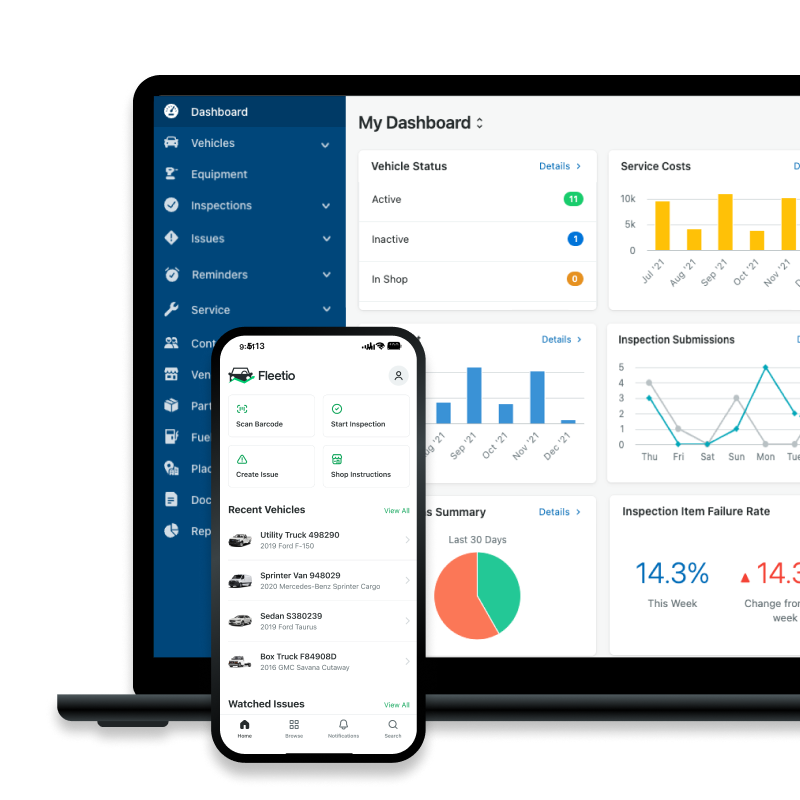Preventive Maintenance Should Be Your First Safety System
Every skipped inspection, delayed work order or missed PM interval introduces risk. This guide explores how maintenance discipline directly impacts safety, and how your team can track, prove and improve it every day
Jun 16, 2025
13 min read

Summary
Preventive maintenance isn’t just about uptime – it’s your fleet’s first line of defense against safety incidents and operational risk. From inspections to service completion times, this guide shows how to turn maintenance workflows into measurable safety strategies. Learn what metrics to track, what habits to enforce, and how today’s most accountable fleets turn their shops into safety hubs.
Jump to a topic
🧭 Introduction: Why Safe Fleets Start in the Shop
For many fleets, safety and maintenance live in separate silos. Safety teams focus on training and compliance, while maintenance teams are tasked with keeping vehicles moving and costs down. But the reality is that every delayed inspection, missed service and open work order creates risk: Risk to your people, your uptime and your bottom line.
Preventive maintenance isn’t just about avoiding breakdowns. It’s a measurable safety strategy. And when you embed it into your fleet’s operations, you build a culture of accountability that spans drivers, technicians and managers alike.
This guide will walk through the connection between maintenance discipline and operational risk reduction and show how modern fleets use their tools, data and workflows to not only reduce costs, but also prevent incidents before they happen.
What you'll find:
- Common patterns that create hidden risk in fleet operations
- Actionable steps to reduce safety incidents through maintenance workflows
- Tools and metrics that help you track and enforce safer practices
- A checklist to help you evaluate your current exposure
Whether you're a fleet manager, operations director or safety leader, this guide will help you operationalize safety at the maintenance level and prove its impact across the board.
1. Proactive Maintenance Is Smart AND Safe
The term “preventive maintenance” is an ever-present one in fleet management, but its true value often gets taken for granted, and often buried in spreadsheets or audit reports. At its core, proactive maintenance is about controlling risk. When done right, it systematically reduces the chances of mechanical failure, costly downtime, compliance violations, and most importantly, driver harm.
🧠 The Insight
Most serious mechanical failures are predictable. And predictable means preventable.
Brake wear, tire blowouts, powertrain failures… these aren’t freak accidents. They’re often the result of skipped inspections, deferred service or poor visibility across roles. When vehicles fall through the cracks, safety goes with them.
A study by FMCSA found that nearly 30% of all truck accidents involved a mechanical factor that could have been identified during routine inspection or maintenance.
✅ Recommended Actions
1. Lock in a consistent PM schedule for every asset.
Avoid guesswork and backlogs by enforcing mileage- or time-based intervals.
- Tool Tip: Use Fleetio’s Service Programs to automate PM scheduling across asset types and set escalation rules when service is overdue.
2. Treat inspections like your first line of safety.
Walkaround inspections can catch issues before they turn into safety events, but only if drivers take them seriously.
- Tool Tip: Digital Inspections in Fleetio standardize checks, enforce compliance, and immediately flag issues for action.
- Metric to Monitor: % of inspections completed on time; % with safety-critical issues flagged
3. Don’t delay safety-related work orders.
Backlogs are unavoidable sometimes, but safety-related tasks should be your top triage priority.
- Tool Tip: Use issue severity tags and service priority queues to elevate high-risk repairs.
- Metric to Monitor: Avg. time to complete high-priority work orders; % of overdue safety-related tasks
🧰 Measurement Matters
These aren’t just operational KPIs. They’re leading indicators of risk. And when shared across teams, they give everyone, from the shop floor to the C-suite, a clearer picture of how maintenance affects safety.
To frame maintenance as a safety strategy, you have to prove it’s working. Start tracking:
| Metric | Why It Matters | How to Measure It |
|---|---|---|
| Inspection resolution time | Shows how quickly your team acts on issues | Track the time between when an inspection issue is reported and when it's resolved, using timestamps in your system or spreadsheet |
| % of inspections completed on time | Indicates driver compliance and program consistency | Compare completed inspections to scheduled ones each day/week |
| % of issues escalated to work orders | Reveals how well safety-critical issues are being addressed | Track how many reported issues result in formal service tasks or work orders |
| Avg. work order completion time | Measures service efficiency and response time | Calculate average time between work order creation and closure |
| Missed PM intervals | Highlights where delays could lead to risk | Review service logs to find overdue or skipped maintenance intervals |
2. The Chain of Risk: What Happens When Maintenance Lags
Safety incidents rarely happen in isolation. Most are the result of a domino effect (a missed inspection here, a delayed repair there) that quietly erodes your safety net until something breaks. By the time the risk is visible, it’s already too late.
This section breaks down how small operational breakdowns lead to real-world safety consequences, and how fleets can stop risk from building up on itself in the first place.
🧠 The Insight
Reactive maintenance doesn’t just increase downtime. It increases liability.
When vehicles aren’t maintained proactively, drivers are forced to operate in the gray area between “safe” and “maybe just one more trip.” Whether it’s worn brakes, underinflated tires, or a check engine light that’s been ignored for two weeks, that ambiguity leads to hesitation, accidents and violations.
“During CVSA’s 2023 International Roadcheck, 17.5% of commercial vehicles were placed out of service for mechanical violations.” Source: CVSA
⚠️ Common Failure Chains
Here are a few common maintnance breakdown scenarios and how they play out across roles:
Scenario 1: Skipped PM → Unsafe Brakes → Rear-End Collision
- PM interval is missed during a busy season
- No one notices until a driver logs soft brakes on their inspection
- Work order is delayed due to backlog
- Vehicle stays in service
- Driver rear-ends another vehicle when stopping distance is reduced
Result: Injury, potential lawsuit, DOT citation for mechanical defect
Scenario 2: Incomplete Inspection → Loose Lug Nut Missed → Wheel Detachment
- Driver rushes pre-trip inspection, doesn’t log anything
- Vehicle is cleared without technician review
- At highway speed, the wheel detaches from the vehicle
- Entire lane is blocked, vehicle is towed, damages occur
Result: $10,000+ incident, possible negligence claim
Scenario 3: Delayed Work Order → Repeated Fault Code → FMCSA Violation
- Vehicle throws engine fault, logged by driver in inspection
- Fleet manager marks it low-priority and defers action
- Vehicle is pulled over during a random inspection
- Fault is still active, leading to an OOS order
Result: Downtime, citation, and compliance audit risk
✅ Recommended Actions
1. Create defined thresholds for “safe to operate.”
Don’t leave decisions up to gut-feel. Create clear policies for which issues must trigger a repair before operation.
- Tool Tip: Use Fleetio’s Issue Priority Levels to categorize and enforce repair rules by risk level
- Action: Publish a shared doc for drivers and techs outlining red-flag issues
2. Integrate inspections directly into maintenance workflows.
Inspection results shouldn’t live in a vacuum. They should generate issues, assign work and close the loop, ideally automatically.
- Tool Tip: Set inspection responses to auto-generate issues for work orders in Fleetio
- Metric to Monitor: Avg. time between inspection issue and service assignment
3. Prioritize visibility into open safety issues.
Fleet managers can’t triage what they can’t see. Build reporting views that surface unresolved safety risks in real time.
- Tool Tip: Use Fleetio’s Issues Report filtered by safety-related keywords or high severity
- Action: Schedule a weekly safety risk review with operations and maintenance leads
🧰 Measurement Matters
When safety breaks down, it’s rarely from a single point of failure. It’s the result of operational drift, or small delays and missed signals that add up over time. The good news is you can measure it, catch it and correct it before it costs you.
| Metric | Why It Matters | How to Measure It |
|---|---|---|
| PM compliance rate | Core indicator of maintenance discipline | Calculate the percentage of scheduled PM tasks completed on time within a given period |
| % of unplanned maintenance | Reveals how much work is reactive vs. proactive | Divide the number of unscheduled repairs by total service events for a given timeframe |
| Safety-critical failures | Helps uncover recurring risks like brake or tire issues | Tag and track the types of failures in service or inspection logs |
| Repeat issues by asset | Flags recurring failures or unresolved root causes | Identify patterns in issue logs or service history for individual vehicles |
| Avg. time between services | Helps evaluate if maintenance intervals are too long or short | Track average time or mileage between service events for each asset |
Make PM your fleet’s competitive advantage
Reduce downtime, catch issues early and automate service workflows with Fleetio’s preventive maintenance tools. Keep every asset on schedule – no spreadsheets required.
Explore PM features3. From Cost Center to Safety System: Reframing Maintenance ROI
Fleet maintenance has traditionally been seen as a necessary expense. Budgets are scrutinized, costs are tracked, and the conversation usually starts (and ends) with how to make it cheaper.
But when you start looking at maintenance through a safety and risk lens, the ROI picture changes dramatically.
Proactive maintenance reduces the frequency and severity of incidents. It lowers your insurance premiums, protects your reputation, improves compliance scores and keeps vehicles, and people, out of harm’s way. And you can measure all of it.
🧠 The Insight
Safe fleets don’t just save money… they avoid losses.
A single preventable incident, whether it’s a brake failure or a tire blowout, can cost more than a year’s worth of proactive maintenance. That includes vehicle damage, injury claims, legal fees, replacement rentals and the soft costs of lost time and shaken confidence.
According to the Network of Employers for Traffic Safety (NETS), the average on-the-job crash costs employers $74,000, and over $500,000 if it results in a fatality.
🧮 Calculating the Real ROI
Here’s how to shift your team’s mindset from cost control to risk control.
| Expense Type | Traditional View | Safety-First View |
|---|---|---|
| Preventive Maintenance | Recurring cost to minimize downtime | Investment in incident prevention |
| Repairs | Expense to be minimized | Opportunity to catch risk early |
| Inspections | Compliance checkbox | Critical safety data pipeline |
| Technician Time | Overhead | Frontline safety force |
✅ Recommended Actions
1. Reframe PM costs as risk mitigation in executive reporting.
Instead of reporting maintenance costs in isolation, include data points on avoided downtime, reduced incidents or inspection pass rates.
- Tool Tip: Use Fleetio’s reporting to tie PM compliance rates to trends in unplanned maintenance and inspection failures
- Metric to Report: Trendline of PM compliance vs. number of unplanned repairs or safety-critical breakdowns
2. Work with your insurance provider to quantify value.
Some insurers offer premium reductions or safety incentives for fleets that show strong PM discipline and digital records.
- Action: Export maintenance and inspection records from Fleetio to share during renewal negotiations
- Tool Tip: Use Fleetio’s Service History and Issues Log to create an audit trail
3. Track cost avoidance, not just cost control.
Start collecting data on the cost of incidents you prevented by catching issues early.
- Action: Build a simple internal log of “caught just in time” issues and tie each one to its potential impact (e.g. tire tread failure avoided, $4,000 saved)
- Metric to Monitor: Value of avoided costs per quarter
🧰 Measurement Matters
Maintenance doesn’t just protect vehicles. It protects budgets, people and reputations. The more you operationalize it as a risk management strategy, the more credibility and influence your maintenance program earns across your organization.
| Metric | Why It Matters | How to Measure It |
|---|---|---|
| PM compliance rate | Key input for cost and risk management | Track what percentage of PM tasks are done on schedule |
| % of unplanned maintenance events | High rate often means higher costs and lower uptime | Compare planned vs. unplanned work based on maintenance records |
| Avg. cost of safety-related incidents | Connects maintenance to real-world financial impact | Collect cost data from accidents, violations or emergency repairs and calculate an average |
| Insurance premiums over time | Reflects perceived fleet risk from underwriters | Review year-over-year changes in insurance costs to see if improvements are reflected |
| Near-miss or “caught in time” logs | Demonstrates risk reduction value to leadership | Keep a record of repairs or inspections that prevented larger incidents or breakdowns |
4. Ready or Risky? A Self-Assessment for Maintenance-Driven Safety
You’ve got vehicles to keep running and costs to manage, but how confident are you that your maintenance program is actively reducing risk?
Use this checklist to assess where your fleet stands today, and where you may be leaving gaps that could lead to compliance issues, safety events or preventable costs.
✅ Maintenance Safety Self-Assessment
For each statement, mark:
🟢 Yes – Fully implemented
🟡 Somewhat – In progress or partially implemented
🔴 No – Not in place
| Statement | Rating |
|---|---|
| We have clear safety thresholds for when a vehicle should be pulled from service | |
| Our drivers know how to escalate safety-critical issues through inspections | |
| Inspection issues auto-generate service tasks or alerts to the maintenance team | |
| We prioritize safety-related work orders over general repairs or cosmetic issues | |
| PM compliance is tracked and reviewed at least monthly | |
| We use digital service history to prove maintenance during audits or insurance reviews | |
| Our insurance premiums have decreased or stabilized due to strong maintenance practices | |
| We regularly review near-misses or “could’ve been worse” repairs to identify trends | |
| Safety metrics are part of regular maintenance and operations reporting | |
| Drivers, technicians and fleet managers share a common understanding of what counts as a safety risk |
🔍 Interpreting Your Score
- 8–10 Green: Your maintenance program is actively supporting a safer fleet. Focus on continuous improvement and storytelling for leadership.
- 5–7 Yellow: You’ve got a solid foundation, but there are blind spots. Pick 2–3 gaps to close this quarter.
- 0–4 Red: Your safety net has holes. Start by defining what “safe to operate” means and building systems to catch issues before they escalate.
🛠 Your Next Steps
If you’re seeing yellow or red on more than a few of the statements above, start here:
1. Align roles on safety priorities.
Make sure drivers, techs and fleet managers are calibrated on what counts as a high-priority safety issue—and how it should be handled.
2. Automate issue detection and escalation.
Use your fleet management system to close the loop between inspections, issues and service workflows.
3. Track outcomes, not just actions.
Go beyond “number of inspections” or “total service events.” Measure how well those actions reduce risk over time.
Maintenance is more than a cost center. It’s your first line of defense against accidents, violations and liability. When you treat it like a safety system, you can build a fleet that’s not just compliant, but confident.
Build a safety culture from the ground up
Fleetio connects inspections, issues and service tasks so safety risks are visible and actionable. Give drivers and techs the tools to report – and resolve – issues before they escalate.
See our workflows in action
Senior Fleet Content Specialist
As a Senior Fleet Content Specialist at Fleetio, Peyton explores the voices and experiences that shape fleet operations. She focuses on how fleet professionals adopt technology, improve efficiency and lead their teams to bring clarity and context to the challenges happening across the industry.
View articles by Peyton PanikReady to get started?
Join thousands of satisfied customers using Fleetio
Questions? Call us at 1-800-975-5304
Get Our Newsletter
Join a community of 70,000+ fleet industry professionals.

